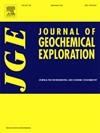巴西北部Carajás矿产省Sossego世界级IOCG矿床热液蚀变、地球化学矢量及其勘探意义
IF 3.4
2区 地球科学
Q1 GEOCHEMISTRY & GEOPHYSICS
引用次数: 0
摘要
iocg型世界级Sossego矿床是位于巴西北部亚马逊河克拉通Carajás矿产省内的一个高CuAu含量(Cu >;0.9 wt%),通常与深部热液化岩石有关。该矿床有Pista、Sequeirinho/Baiano和Sossego/Curral勘探区。其主要寄主岩性为变形或变质花岗岩类、长英质和基性变质火山岩以及超基性岩。对7834个样品的全岩地球化学数据集进行了多元统计分析,确定了iocg型矿化特征,并约束了在杂岩体中观察到的明显岩石地球化学单元。数据处理包括基于这些部门和主要和微量化学元素的矿物学关联的各种图表,这些图表定义了表征的参数和限制。皮斯塔区显示了5个岩石地球化学单元,突出显示了靠近矿带的高硅、高钠和低铁值的单元。在Sequeirinho/Baiano,出现了9个单元,其中矿带的远端部分显示出高钠值;钠、钙在中间部分逐渐向中位数变化;在靠近矿化的地方获得高铁、钙和锰的含量。Sossego/Curral段有7个岩石地球化学单元,其中离成矿带较远的单元钠值较高,而离矿石较近的单元则富含钾、锰、铁和钙。基于软件的隐式三维建模和AIOCG 1和AIOCG 2地球化学指标将这些岩石地球化学单元物化到向量中,并直观地显示了热液流的地质概览、它们可能的矿物共生作用以及与矿化带的相关性。因此,这些结果有助于Sossego复合体的勘探,为地质冶金研究、矿山作业改进和可预测性、安全性提高以及减少支出的更好的矿石处理程序提供数据。本文章由计算机程序翻译,如有差异,请以英文原文为准。
Hydrothermal alterations, geochemical vectoring, and their implications for the world-class Sossego IOCG deposit exploitation, Carajás Mineral Province, northern Brazil
The IOCG-type world-class Sossego deposit is a complex within the Carajás Mineral Province, Amazonian Craton (northern Brazil), with high Cu![]() Au contents (Cu > 0.9 wt%) usually related to intensively hydrothermalized rocks. This deposit has the Pista, Sequeirinho/Baiano, and Sossego/Curral exploratory sectors. Their prevalent host lithologies are deformed or metamorphosed granitoids, felsic and mafic metavolcanics, and ultramafic rocks. Multivariate statistical analyzes of a broad whole-rock geochemical dataset (7834 samples) allow the characterization of the signatures of IOCG-style mineralization and constrain the conspicuous lithogeochemical units observed at the complex. Data treatment encompasses various diagrams based on the mineralogical association of these sectors and major and trace chemical elements that define parameters and limits for the characterization. The Pista sector reveals five lithogeochemical units, highlighting those with high silica and sodium and low iron values in areas closer to the ore zone. At the Sequeirinho/Baiano, nine units appear, where the distal portions to the ore zone reveal high sodium values; gradually changing to median values of sodium and calcium at the intermediate portion; and reaching high values of iron, calcium, and manganese closer to the mineralization. The Sossego/Curral sector has seven lithogeochemical units, where the more distal units to the mineralization zone have high sodium values, whereas those closer to the ore reveal enrichment in potassium, manganese, iron, and calcium. Implicit software-based 3D modeling and the AIOCG 1 and AIOCG 2 geochemical indices materialize these lithogeochemical units within vectors and visually show an enhanced geological overview of hydrothermal flows, their probable mineralogical paragenesis, and correlations with the mineralized zones. Hence, these results contribute to the Sossego Complex exploration, providing data for geometallurgical studies, mine operations improvement and predictability, safety increases, and better ore processing routines with expenditure reductions.
Au contents (Cu > 0.9 wt%) usually related to intensively hydrothermalized rocks. This deposit has the Pista, Sequeirinho/Baiano, and Sossego/Curral exploratory sectors. Their prevalent host lithologies are deformed or metamorphosed granitoids, felsic and mafic metavolcanics, and ultramafic rocks. Multivariate statistical analyzes of a broad whole-rock geochemical dataset (7834 samples) allow the characterization of the signatures of IOCG-style mineralization and constrain the conspicuous lithogeochemical units observed at the complex. Data treatment encompasses various diagrams based on the mineralogical association of these sectors and major and trace chemical elements that define parameters and limits for the characterization. The Pista sector reveals five lithogeochemical units, highlighting those with high silica and sodium and low iron values in areas closer to the ore zone. At the Sequeirinho/Baiano, nine units appear, where the distal portions to the ore zone reveal high sodium values; gradually changing to median values of sodium and calcium at the intermediate portion; and reaching high values of iron, calcium, and manganese closer to the mineralization. The Sossego/Curral sector has seven lithogeochemical units, where the more distal units to the mineralization zone have high sodium values, whereas those closer to the ore reveal enrichment in potassium, manganese, iron, and calcium. Implicit software-based 3D modeling and the AIOCG 1 and AIOCG 2 geochemical indices materialize these lithogeochemical units within vectors and visually show an enhanced geological overview of hydrothermal flows, their probable mineralogical paragenesis, and correlations with the mineralized zones. Hence, these results contribute to the Sossego Complex exploration, providing data for geometallurgical studies, mine operations improvement and predictability, safety increases, and better ore processing routines with expenditure reductions.
求助全文
通过发布文献求助,成功后即可免费获取论文全文。
去求助
来源期刊

Journal of Geochemical Exploration
地学-地球化学与地球物理
CiteScore
7.40
自引率
7.70%
发文量
148
审稿时长
8.1 months
期刊介绍:
Journal of Geochemical Exploration is mostly dedicated to publication of original studies in exploration and environmental geochemistry and related topics.
Contributions considered of prevalent interest for the journal include researches based on the application of innovative methods to:
define the genesis and the evolution of mineral deposits including transfer of elements in large-scale mineralized areas.
analyze complex systems at the boundaries between bio-geochemistry, metal transport and mineral accumulation.
evaluate effects of historical mining activities on the surface environment.
trace pollutant sources and define their fate and transport models in the near-surface and surface environments involving solid, fluid and aerial matrices.
assess and quantify natural and technogenic radioactivity in the environment.
determine geochemical anomalies and set baseline reference values using compositional data analysis, multivariate statistics and geo-spatial analysis.
assess the impacts of anthropogenic contamination on ecosystems and human health at local and regional scale to prioritize and classify risks through deterministic and stochastic approaches.
Papers dedicated to the presentation of newly developed methods in analytical geochemistry to be applied in the field or in laboratory are also within the topics of interest for the journal.
 求助内容:
求助内容: 应助结果提醒方式:
应助结果提醒方式:


